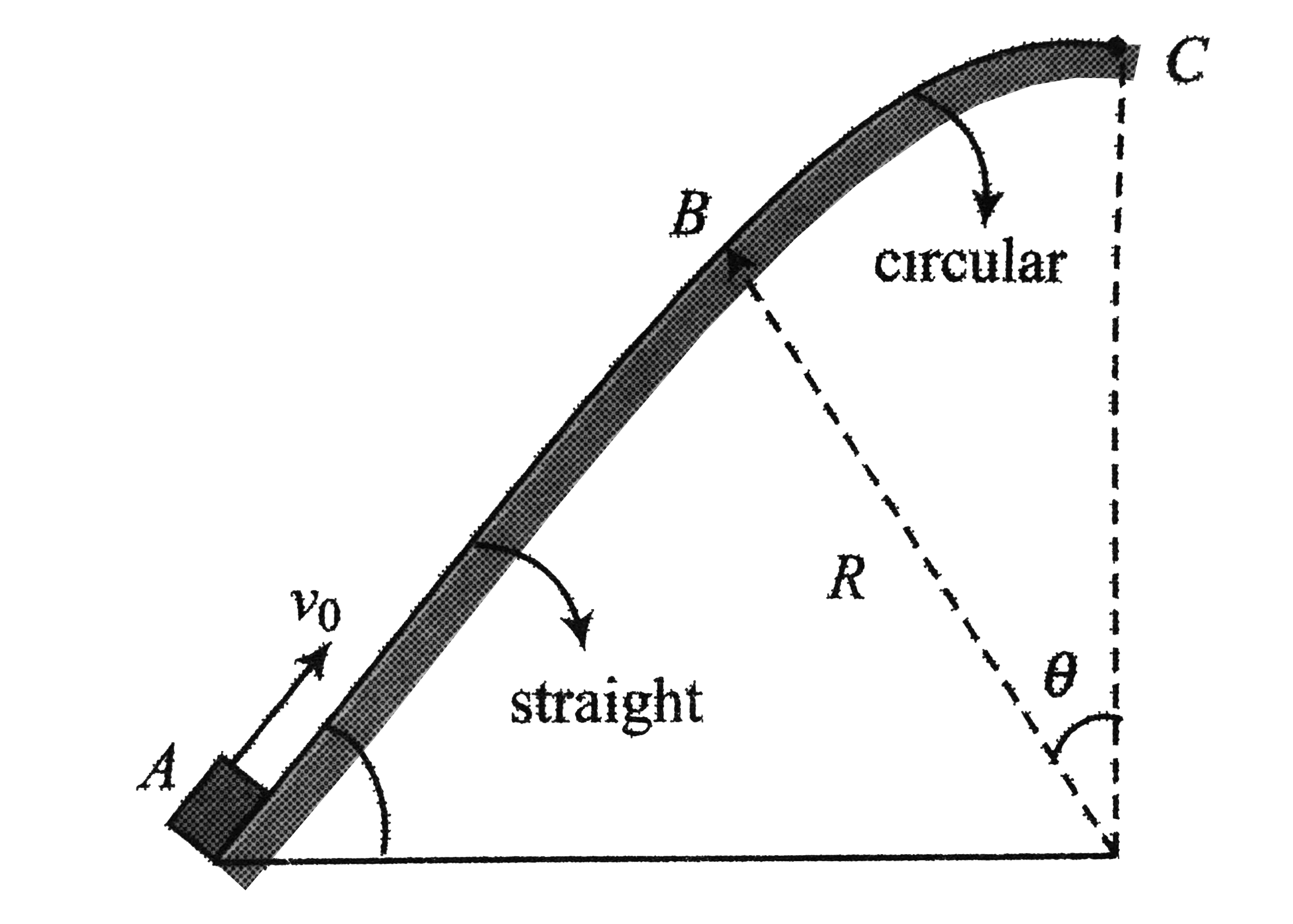A block of mass m slides from the top of an inclined plane of angle of inclination θ & length l. The coefficient of friction between the plane and the block is μ. Then it is observed over a distance d along the horizontal surface having the same coefficient of friction μ, before it comes to a stop. Find the value of d.
The correct Answer is:l[sinθ−μcosθ]/μ
To solve the problem, we need to analyze the motion of the block on the inclined plane and then on the horizontal surface.
1. Identify Forces on the Inclined Plane:
- The weight of the block is mg.
- The component of gravitational force acting down the incline is mgsinθ.
- The normal force acting on the block is N=mgcosθ.
- The frictional force opposing the motion is Ffriction=μN=μmgcosθ.
2. Net Force and Acceleration on the Inclined Plane:
- The net force acting on the block along the incline is:
Fnet=mgsinθ−μmgcosθ
- According to Newton's second law, this net force equals mass times acceleration:
ma=mgsinθ−μmgcosθ
- Dividing through by m:
a=gsinθ−μgcosθ
3. Calculate the Velocity at the Bottom of the Incline:
- Using the kinematic equation v2=u2+2as where u=0 (initial velocity), a=gsinθ−μgcosθ, and s=l:
v2=0+2(gsinθ−μgcosθ)l
- Therefore, the velocity at the bottom of the incline is:
v2=2l(gsinθ−μgcosθ)
4. Motion on the Horizontal Surface:
- On the horizontal surface, the only force acting against the motion is the frictional force:
Ffriction=μmg
- The deceleration (retardation) due to friction is:
a′=−μg
5. Calculate the Distance d on the Horizontal Surface:
- Using the kinematic equation again v′2=u′2+2a′s′ where v′=0 (final velocity), u′=v (initial velocity from the incline), and a′=−μg:
0=v2+2(−μg)d
- Rearranging gives:
d=v22μg
- Substituting v2 from the previous step:
d=2l(gsinθ−μgcosθ)2μg
- Simplifying:
d=l(gsinθ−μgcosθ)μg
- This can be further simplified to:
d=l(sinθ−μcosθ)μ
Final Answer:
d=l(sinθ−μcosθ)μ
- The weight of the block is mg.
- The component of gravitational force acting down the incline is mgsinθ.
- The normal force acting on the block is N=mgcosθ.
- The frictional force opposing the motion is Ffriction=μN=μmgcosθ.
- The net force acting on the block along the incline is:
Fnet=mgsinθ−μmgcosθ
- According to Newton's second law, this net force equals mass times acceleration:
ma=mgsinθ−μmgcosθ
- Dividing through by m:
a=gsinθ−μgcosθ
- Using the kinematic equation v2=u2+2as where u=0 (initial velocity), a=gsinθ−μgcosθ, and s=l:
v2=0+2(gsinθ−μgcosθ)l
- Therefore, the velocity at the bottom of the incline is:
v2=2l(gsinθ−μgcosθ)
- On the horizontal surface, the only force acting against the motion is the frictional force:
Ffriction=μmg
- The deceleration (retardation) due to friction is:
a′=−μg
- Using the kinematic equation again v′2=u′2+2a′s′ where v′=0 (final velocity), u′=v (initial velocity from the incline), and a′=−μg:
0=v2+2(−μg)d
- Rearranging gives:
d=v22μg
- Substituting v2 from the previous step:
d=2l(gsinθ−μgcosθ)2μg
- Simplifying:
d=l(gsinθ−μgcosθ)μg
- This can be further simplified to:
d=l(sinθ−μcosθ)μ
d=l(sinθ−μcosθ)μ
Similar Questions
A block of mass m slides down an inclined plane of inclination θ with uniform speed. The coefficient of friction between the block and the plane is μ. The contact force between the block and the plane is
View SolutionA block of mass m moves with constant speed down the inclined plane of inclination θ. Find the coefficient of kinetic friction.

View Solution
Knowledge Check
A block of mass 2kg rests on a rough inclined plane making an angle of 30∘ with the horizontal. The coefficient of static friction between the block and the plane is 0.7. The frictional force on the block is
A10.3NB23.8NC11.9ND6.3N
A block of mass m slides down an inclined plane which makes an angle θ with the horizontal. The coefficient of friction between the block and the plane is μ. The force exerted by the block on the plane is
View SolutionA block of mass m is at rest on a rough inclined plane of angle of inclination θ. If coefficient of friction between the block and the inclined plane is μ, then the minimum value of force along the plane required to move the block on the plane is
View SolutionA block slides down on inclined plane (angle of inclination 60∘ ) with an accelration g/2 Find the coefficient friction

View SolutionA block of mass 2 kg slides down an incline plane of inclination 30°. The coefficient of friction between block and plane is 0.5. The contact force between block and plank is :
View SolutionA block of mass 2kg rests on a rough inclined plane making an angle of 30∘ with the horizontal. The coefficient of static friction between the block and the plane is 0.7. The frictional force on the block is
View SolutionA block of mass m is projected up with a velocity v0 along an inclined plane of angle of inclination θ=37∘. The coefficient of friction between the inclined plane AB and blocks is μ(=tanθ). Find the values of v0 so that the block moves in a circular path from B to C.

View SolutionA hollow sphere of mass m and radius R is rolling downdard on a rough inclined plane of inclination θ. If the coefficient of friction between the hollow sphere and incline is μ, then
View Solution